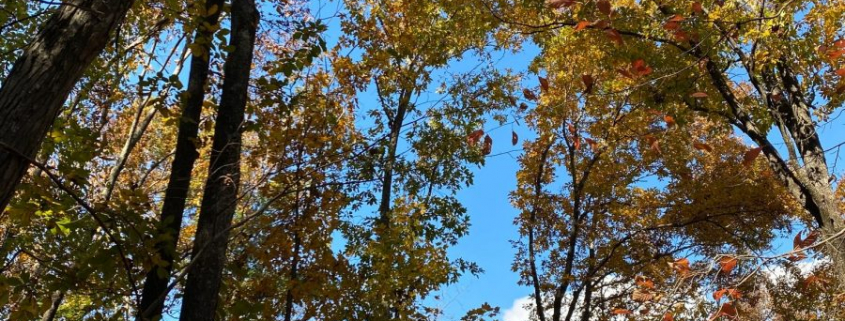A Land Legacy Gift Ahead for Wild Alabama
October 28, 2022, I visited a Lawrence County woodland property that the owners are donating to Wild Alabama, whose mission is to inspire people to enjoy, value, and protect the wild places in Alabama. Headquartered in Moulton, Wild Alabama (http://www.wildal.org) launched on January 1, 2021 with Maggie Johnston (maggie@wildal.org) as Executive Director. Maggie led our tour of the property, accompanied by staff members Janice Barrett, Kim Waites, and intern Jonathan Kelly, and John and Rhonda Riley, the couple who owns the subject property, along with Jim Lacefield (author Lost Worlds in Alabama Rocks), geologist, Nature enthusiast, and longtime friend of the conservation groups that conceived and spun off Wild Alabama. Maggie and her team have plans in the works and hope to establish a headquarters building and education center on a seven-acre roadside parcel within the aggregate 47-acre property, which is located about six miles south of Moulton.
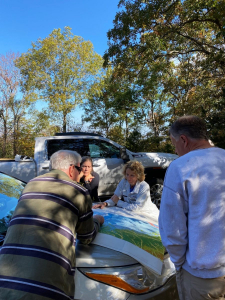
The forest occupies generally rough, rocky terrain that rises from the road, then dips into a valley that abuts a nearby limestone quarry. I would like to spend more time this coming spring with map in hand, gaining a more complete picture of the tract and understanding the forest stands that define the full 47 acres, and the prior land use. Upland mixed hardwood and Eastern red cedar compose the forest across most of the area explored.
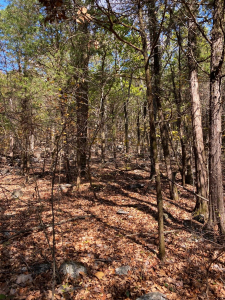
Fall yellows dominated the palette. Leaf-covered, steep ground took us downslope to the backside. The photo depicts a fully stocked upland forest reflecting the poor site quality on this slope, which also extended to the higher reaches. Until we reached the lower slopes, short tree heights and low basal area prevailed.
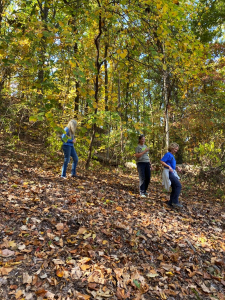
Similar stand conditions greeted us as we left the vehicles and ascended the tract. That’s John Riley in the photo at left. Rhonda is conversing with Jim Lacefield at right.
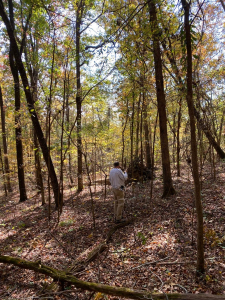
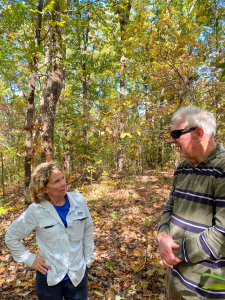
I found some evidence, yet not complete, of past land use. Among the second growth hardwoods and cedar, I saw some scattered older relicts, including this large-crowned, hollow oak that stood prior to the stand that now predominates. Perhaps 100+ feet uphill, beyond the oak, another old residual oak that is likewise a relict is visible. More time on the ground sleuthing will enable constructing a clearer picture of prior use and practice. Such exploration is more revealing during the dormant season when visibility within the forest better accommodates.
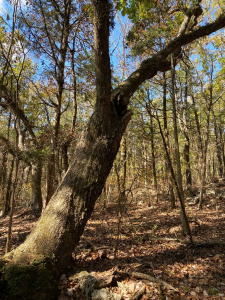
A Fallen Green Ash
As we dropped into the lower ground on the backside, deeper, richer soils enabled growth of this 30-inch diameter green ash. However, nothing in Nature is static, the wind-felled ash providing evidence that our forests are dynamic. The large soil-bound root mass reveals the deeper, richer site. Jonathan, who is about 6’2″ provides scale for this fallen forest champion.
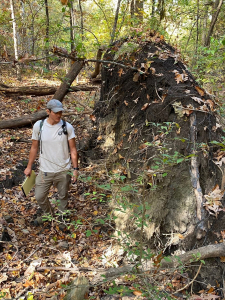
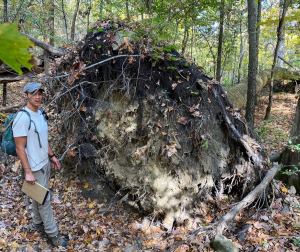
The trunk and top extend at least 100 feet from the base.
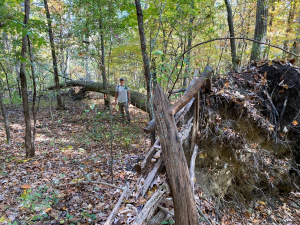
Here is the 1:58 video I recorded at the fallen ash:
I offer this set of recommendations to Maggie:
- Conduct a dormant season inventory of the property, mapping stand delineation, composition, and structure.
- Complete a total species list of trees, shrubs, and woody understory.
- Establish permanent photo-plots at interesting places throughout the 47 acres, including at the fallen ash. The forest will change. Wild Alabama will persist as an education and conservation enterprise for decades and beyond. Historic photos tell a compelling tale to future generations.
- This coming spring, begin a season by season almanac of wildflowers.
- Other tasks will emerge.
Eastern Red Cedar Harvesting
An obvious additional task relates to this next series of photos. We transected several acres (to be mapped with subsequent examination) of mixed cedar and oak where cedar stumps (six to 12 inches in diameter and eight to 12 inches tall) stood above the leaf litter.
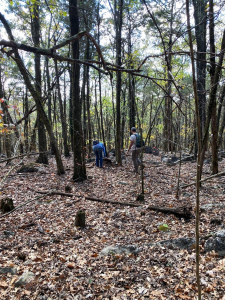
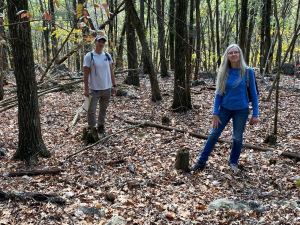
Based upon level of decomposition (red cedar is very decay resistant) I estimate that harvesting took place as long as 20 years ago. I recommend that staff pursue sale forensics (prior owner records) to document the applied practice. I have not encountered in my north alabama wanderings direct evidence of a red cedar harvest/sale. The stumps suggest a dense stand of cedar prior to harvest.
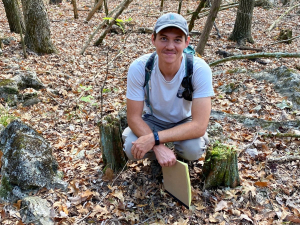
The harvest and sale details will constitute a chapter in the land’s history…part of the compelling story that has bearing on the present and future forest, and instructs the education efforts over time on the property.
One of the stumps supports a resurrection fern and moss terrarium, surrounded by red oak and chinkapin oak leaves. Nature’s handiwork can seldom be matched by human artists.
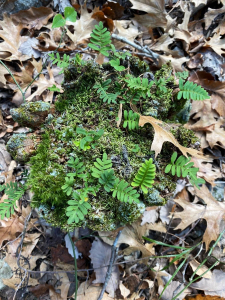
Smiling faces corroborated that few things match a walk in the autumn woods. John Muir concurred:
And into the forest I go, to lose my mind and find my soul.
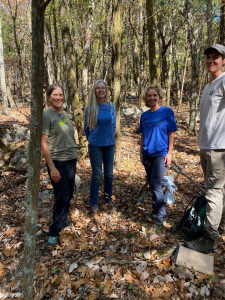
I commend John and Rhonda, the benefactors, who share the Wild Alabama dream. May their gift enable and inspire countless future visitors to lose their mind and find their soul!
A Panoply of Plant Community Citizens
I am convinced with this one short visit that the property offers a rich library of native plants. We found fragrant sumac (left) in full color and Carolina buckthorn (right).
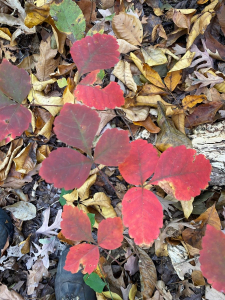
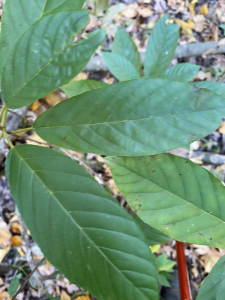
Rusty blackhaw bears fruit that the birds haven’t yet harvested. Its leaves, while not colorful, are displaying blemishes typical of late fall.
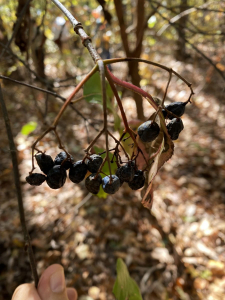
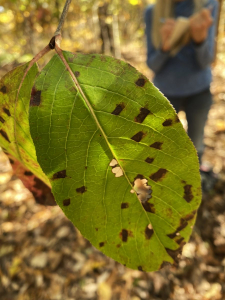
Rusty blackhaw, a small tree or shrub, has fine blocky bark similar to dogwood.

Possumhaw still hangs on to a few very red berries. The season is rapidly closing, even with its leaves (right) still green.
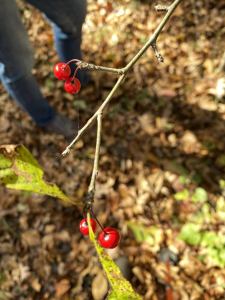
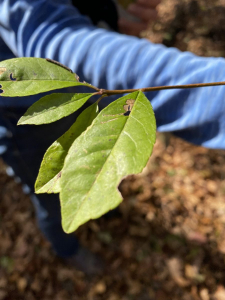
I was surprised to see chinkapin oak common across the upland. I’ve come to expect it on the riparian forests that I frequent. I learn something new every time I enter the forest with eyes open and curiosity engaged.
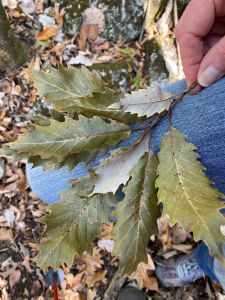
Einstein would have agreed, as he, too, marveled at the mysteries of Nature:
The most beautiful gift of nature is that it gives one pleasure to look around and try to comprehend what we see.
A new one for me, we identified purple stem cliffbake.
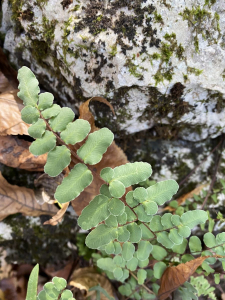
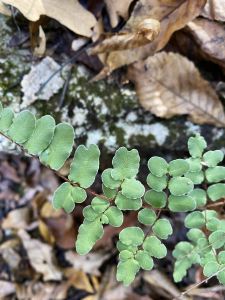
And here we found a different cliffbake this one with narrower leaves.
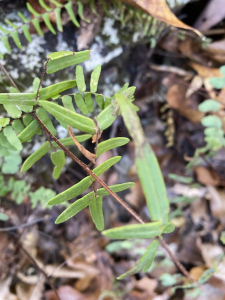
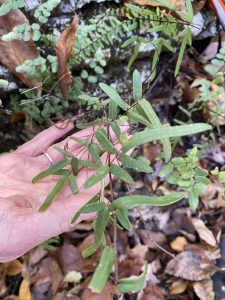
Cliffbrake, I since discovered from an online source, Britannica, is any of about 40 species of ferns of the genus Pellaea. Cliff brake ferns grow on or among rocks, mostly limestone (as is the subject property), throughout the world. Several species, including button fern (Pellaea rotundifolia) and sickle fern (P. falcata), are grown as indoor ornamentals.
Cliff brakes are small plants with mostly leathery leaves emerging from a creeping rhizome. They are characterized by spore-bearing structures (sporangia) that occur in round or elongated clusters (sori) on the margins of fertile leaves. Overlapping leaf margins form a protective covering.
Ebony spleenwort is another small fern, but not of the cliffbake genus.
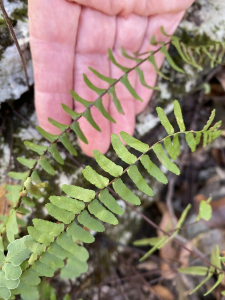
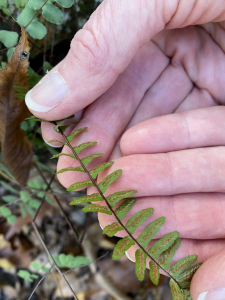
Missouri Department of Conservation: Ebony spleenwort is a perennial fern bearing clusters of leaves. The leaves are 1-time pinnately (feather) compound, linear to narrowly oblong in overall outline, and are dimorphic (there are two forms): The vegetative (sterile) leaves are shorter, lie prostrate on the ground or are arching, have shorter leaflets, and are evergreen. The fertile (spore-bearing) leaves are longer, stand erect, have longer leaflets, and are deciduous (the leaflets fall off in winter). The shiny, wiry leaf stems are reddish brown to dark brown their entire length (to nearly the very tip of the leaf). The leaflets are mostly alternate, shallowly (sometimes deeply) toothed, and eared at the base of the upper margin. The bases of the leaflets overlap the main stalk. Spores are produced May–September.
We relished our autumn woods-ramble, contemplating what such a gift of land could enable Wild Alabama to accomplish in the realm of Nature education, inspiration, and dreams. All of us expressed gratitude for the time shared and the possibilities imagined. All concurred that our two-hour rambling echoed Muir’s sentiment:
In every walk with Nature one receives far more than he seeks.
I wish Wild Alabama well in bringing the passion of belief to the cause of reason — transforming vision to action…creating a center for education, exploration, and inspiration.
Thoughts and Reflections
I offer these observations:
- A gift of land for noble conservation purposes is an unforgettable and priceless legacy!
- Muir: In every walk with Nature one receives far more than he seeks.
- Einstein: The most beautiful gift of nature is that it gives one pleasure to look around and try to comprehend what we see.
Inhale and absorb Nature’s elixir. May Nature Inspire, Inform, and Reward you!
Note: All blog post images created & photographed by Stephen B. Jones unless otherwise noted. Please circulate images with photo credit: “©2023 Steve Jones, Great Blue Heron LLC. All Rights Reserved.”
Another Note: If you came to this post via a Facebook posting or by an another route, please sign up now (no cost… no obligation) to receive my Blog Post email alerts: http://eepurl.com/cKLJdL
And a Third: I am available for Nature-Inspired Speaking, Writing, and Consulting — contact me at steve.jones.0524@gmail.com
Reminder of my Personal and Professional Purpose, Passion, and Cause
If only more of us viewed our precious environment through the filters I employ. If only my mission and vision could be multiplied untold orders of magnitude:
Mission: Employ writing and speaking to educate, inspire, and enable readers and listeners to understand, appreciate, and enjoy Nature… and accept and practice Earth Stewardship.
Vision:
- People of all ages will pay greater attention to and engage more regularly with Nature… and will accept and practice informed and responsible Earth Stewardship.
- They will see their relationship to our natural world with new eyes… and will understand more clearly their Earth home.
Tagline/Motto: Steve (Great Blue Heron) encourages and seeks a better tomorrow through Nature-Inspired Living!
Steve’s Three Books
I wrote my books Nature Based Leadership (2016), Nature-Inspired Learning and Leading (2017), and Weaned Seals and Snowy Summits: Stories of Passion for Place and Everyday Nature (2019; co-authored with Dr. Jennifer Wilhoit) to encourage all citizens to recognize and appreciate that every lesson for living, learning, serving, and leading is either written indelibly in or is powerfully inspired by Nature.
I began writing books and Posts for several reasons:
- I love hiking and exploring in Nature
- I see images I want to (and do) capture with my trusty iPhone camera
- I enjoy explaining those images — an educator at heart
- I don’t play golf!
- I actually do love writing — it’s the hobby I never needed when my career consumed me
- Judy suggested my writing is in large measure my legacy to our two kids, our five grand kids, and all the unborn generations beyond
- And finally, perhaps my books and Blogs could reach beyond family and touch a few other lives… sow some seeds for the future


All three of my books (Nature Based Leadership; Nature-Inspired Learning and Leading; Weaned Seals and Snowy Summits) present compilations of personal experiences expressing my (and co-author Dr. Wilhoit for Weaned Seals and Snowy Summits) deep passion for Nature. All three books offer observations and reflections on my relationship to the natural world… and the broader implications for society. Order any and all from your local indie bookstore, or find them on IndieBound or other online sources such as Amazon and LifeRich.

